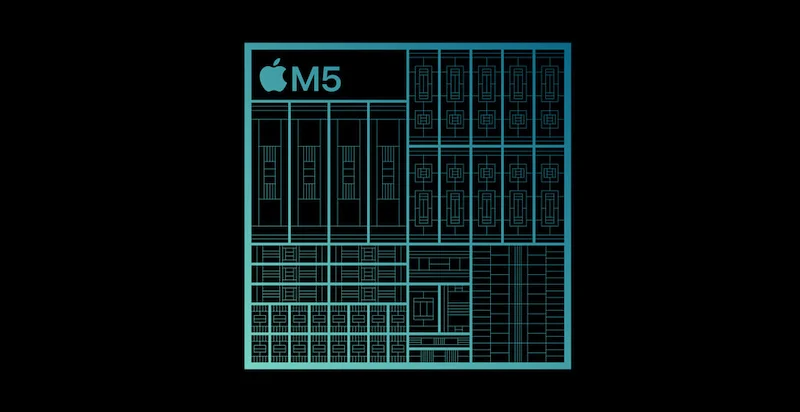Apple’s M5 chip brings per-core neural acceleration, a 30% boost in memory bandwidth, and GPU-driven AI to the MacBook Pro and iPad Pro.
Apple has unveiled the M5, the latest chip in its Apple Silicon lineup, designed around the future of on-device AI.
The new processor adds neural accelerators to every GPU core and pushes peak AI compute performance more than four times beyond the M4, according to Apple. The chip will first ship in the new 14-inch MacBook Pro and updated iPad Pro, where Apple claims up to 3.5 times faster AI performance compared to last-gen devices.

Apple's newest processor, the M5.
While much of the industry focuses on discrete NPUs, Apple’s latest architectural swing leans heavily on GPU-driven AI, unified memory, and a new generation of performance cores to produce a chip that is reshaping how AI is handled inside Apple’s ecosystem.
A Neural Accelerator in Every GPU Core
The core of the M5’s AI uplift lies in its GPU. While Apple has yet to publish TOPS figures, the company has revealed that it added dedicated neural accelerators to every GPU core. These units are directly programmable via Metal’s updated tensor APIs and can be used alongside Core ML and Metal Performance Shaders to run LLMs, generate images, and accelerate other ML tasks.

The M5 may unleash higher AI performance with its next-gen GPU architecture and higher unified memory bandwidth.
The M5 retains a 10-core GPU architecture, now paired with third-generation hardware ray tracing and a claimed 30% boost in graphics performance over the M4. That number jumps to 45% in ray-traced workloads like Cyberpunk 2077, which Apple highlighted during the MacBook Pro launch.
On the memory side, the M5 boosts bandwidth to 153 GB/s—about a 30% gain over the M4—which is critical for the high-throughput demands of local LLM inference and diffusion model image generation. Combined with a faster CPU and memory system, this unlocks new performance ceilings across Apple’s upcoming AI features.
Incremental CPU Shifts, Major GPU Upgrades
The M5 continues Apple’s 10-core CPU layout of four performance plus six efficiency cores, but with Apple claiming a 15% uplift in multithreaded workloads over M4. The CPU uses Apple’s latest performance cores, which the company calls the fastest in any consumer silicon.
On the media side, Apple updated its encode/decode engine to handle advanced formats, and developers can now use Metal 4 APIs to schedule AI workloads more directly on the GPU and neural accelerators. The 16-core neural engine remains in place, but without a disclosed TOPS upgrade. Instead, Apple is steering developers toward GPU+ML workflows, positioning the GPU as the system’s dominant AI engine.

The new iPad Pro with M5.
The M5 will ship first in the 14-inch MacBook Pro and iPad Pro. Apple claims both devices will see up to 3.5 times faster AI performance over their M4 predecessors, with gains tied specifically to real-time LLM inference and image generation.
That performance boost will be most visible in Apple Intelligence, the company’s new suite of on-device AI tools, which rely on Core ML and Metal to run models locally. For developers and engineers, this also opens the door to higher-throughput Core ML applications, particularly those using Apple’s MLX or Metal APIs for stable diffusion, vision transformers, and language models.
Because M5 devices use the same unified memory architecture, performance deltas will show up in benchmarks tied to bandwidth-sensitive tasks like image generation speed and GPU shader throughput in real-time applications. Apple is also positioning the M5 as a more battery-efficient solution, claiming up to 24 hours of runtime on the new MacBook Pro, which, if proven, is a result that would push the edge AI performance-per-watt bar even higher.



